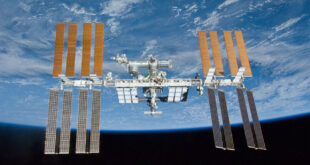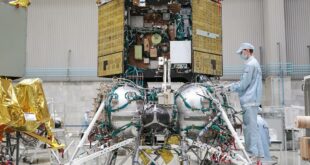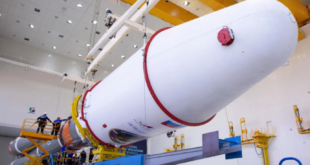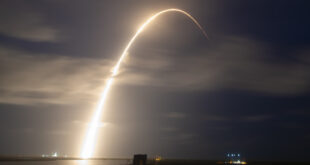
Thessaloniki, 12 April 2024 – According to State Space Corporation Roscosmos anouncements on Thursday 11 April 2024, followed by Agence TASS reports, an Angara-A5 heavy-lift rocket with an Orion booster launched from the Vostochny spaceport in Russia’s Far East on its third attempt.In about 12 minutes, the Orion booster separated from the Angara upper stage and proceeded to a double orbital insertion: first a cube sat in lower orbit, then a test-payload delivered into the targetted geostationary orbit as part of the rocket’s flight development tests.
The Angara-A5 rocket booster first placed a Gagarinets CubeSat created by the Russian private company Avant Space into low-Earth orbit. The Gagarinets CubeSat 3U was engineered by the private company Avant Space and is designed to test the platform’s elements. The insertion In this orbit was executed when the transport and launch container of the Russian company CosmoLab (created with the participation of RSC Energia) successfully opened its bay door for payload release. Once this step was completed, the upper stage launched the mock-up of the main test payload into geostationary orbit, for further transfer to a disposal orbit, where it will remain almost forever.
The Angara-A5 heavy-lift rocket blasted off from the Vostochny spaceport in the Russian Far East at 12:00 p.m. Moscow time (9:00 a.m. GMT) on April 11 after two failed attempts in the previous two days. The Angara-A5 first test-launch from the Vostochny spaceport in Russia’s Far East was initially scheduled for the afternoon of April 9 but the liftoff was cancelled by an automatic safety system two minutes before the launch due to a failure in the oxidizer tank’s pressurizing system.
The second launch attempt was made at 12:00 p.m. Moscow time (9:00 a.m. GMT) on April 10 but the command to cancel the launch and prepare the rocket for a 24-hour stoppage was issued. As Roscosmos Chief Yury Borisov explained, a new technical malfunction emerged relating to a failure in the engine start control system as the results of the telemetric data preliminary analysis showed. The Roscosmos head assured that no irreversible processes requiring the rocket’s dismantling had occurred and technical delays were not unusual while the current testing stage was intended to identify and remove such problems.
This is the first test-flight of the Angara rocket from the Vostochny spaceport in eastern Russia. Previously, these launch vehicles blasted off only from the Plesetsk Cosmodrome in northwestern Russia. The first three launches of Angara heavy rockets from the Plesetsk spaceport took place on December 23, 2014, December 14, 2020 and December 27, 2021. < https://spacewatch.global/?s=Angara+A5 > The launch of the light Angara rocket took place on July 9, 2014 (the suborbital test flight), on April 29, 2022 (the orbital flight) and October 15, 2022 (the orbital flight).
The Angara test-launch from the spaceport has commenced flight development tests of the Amur rocket system that comprises the Angara carrier rocket and the spaceport’s infrastructure. The construction of infrastructure for the Angara rocket at the Vostochny Cosmodrome began in 2019 and late last year 2023 the operational capacity of the technical compound and the launch pad was confirmed during the tests of the Angara-NZh, a full-size mockup of the Angara-A5 rocket. Available olutions allow for launching all types of Angara rockets from one launch pad, from light to heavy carrier vehicles.
The 54.5-metre (178.81-foot) three-stage rocket, with a mass of about 773 tonnes, can carry about 24.5 tonnes into space, according to Russia’s Kommersant newspaper. The defence ministry is also involved in the project. Roscosmos further indicated that the Angara A5 rocket uses only Russian components and less environmentally damaging fuel, and will replace the Proton M as Russia’s heavy-lift rocket, which has been in operation since the mid-1960s.
The most important takeaway, based on the results of this latest test, is that Russia has acquired the ability to launch heavy payloads and geostationary payloads and spacecrafts from its territory. Previously, such an opportunity was only possible from the Baikonur Cosmodrome.
 SpaceWatch.Global An independent perspective on space
SpaceWatch.Global An independent perspective on space




